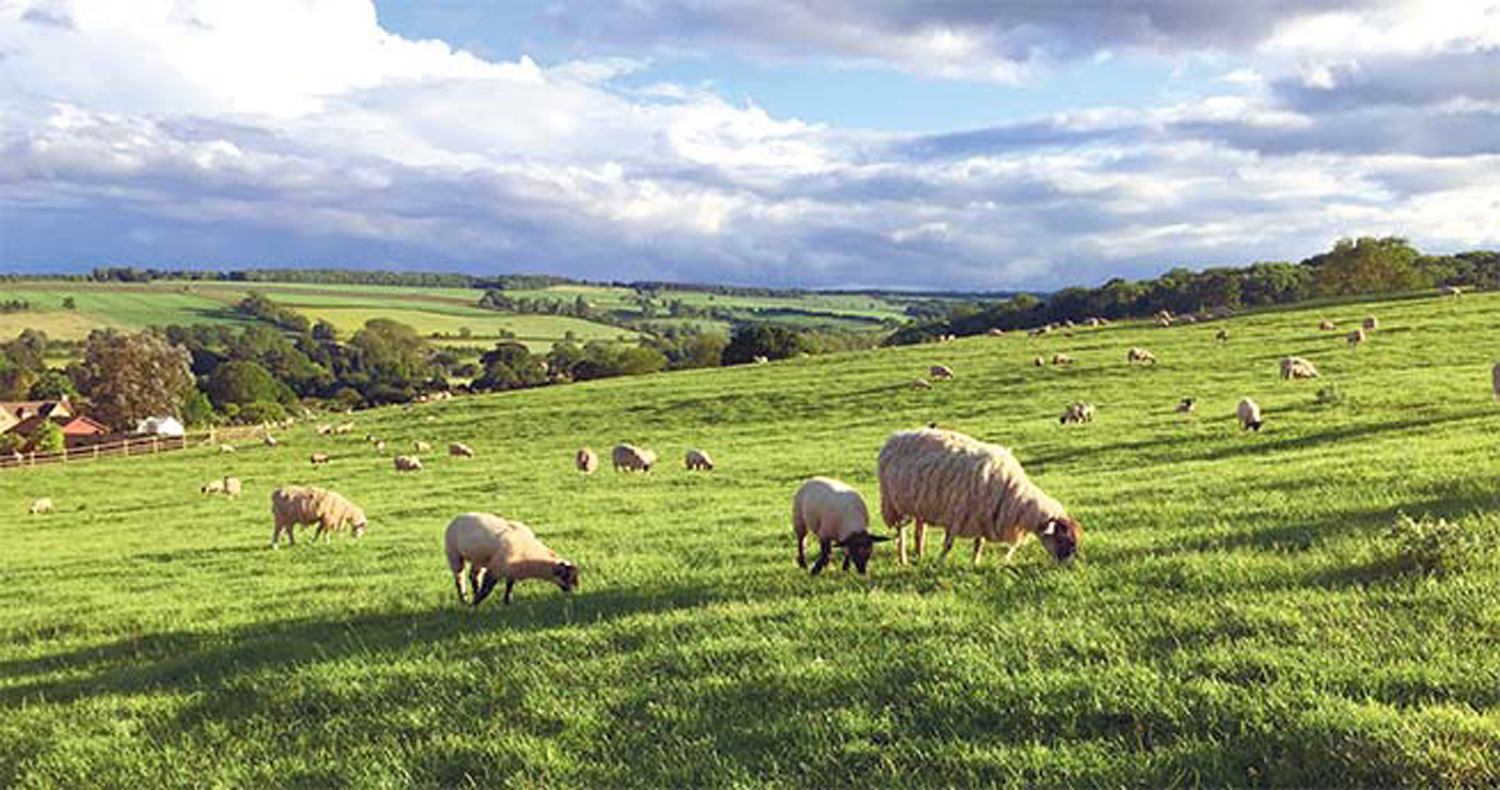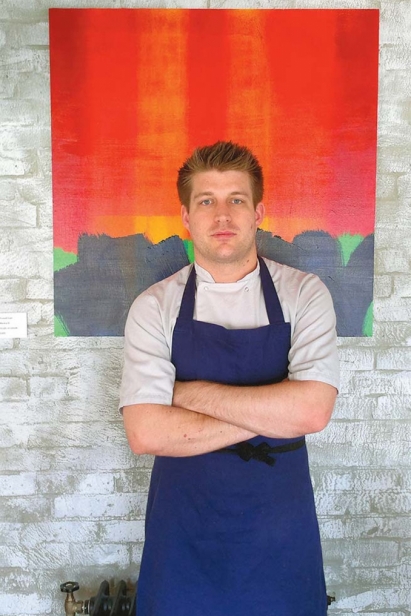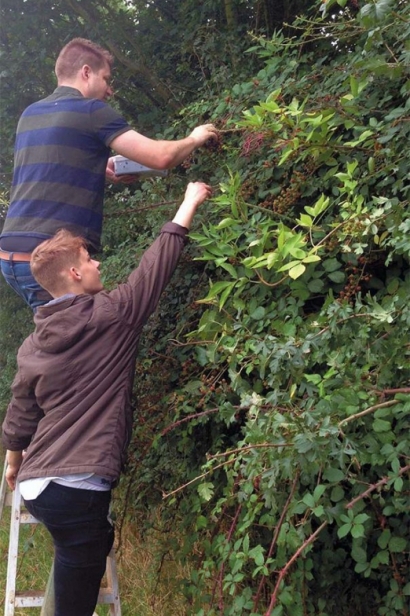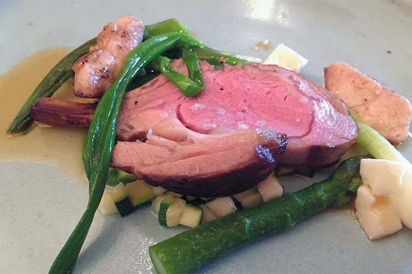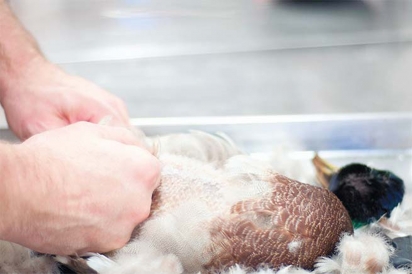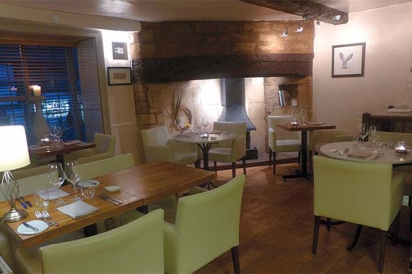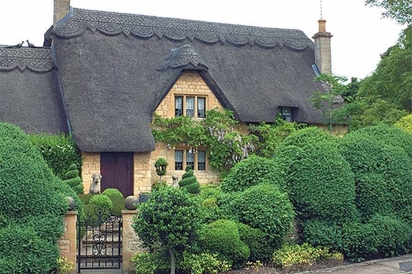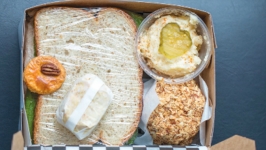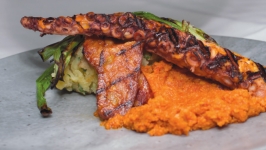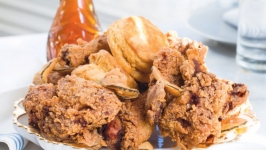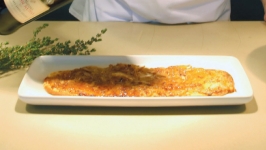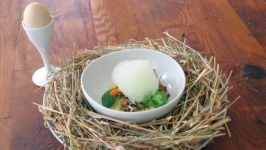Tasting History in Chipping Campden at Chef's Dozen
Culinary craftsmanship at England’s Chef’s Dozen restaurant
Years ago, I worked with a recipe editor who claimed that she always packed cookware when she traveled. Not just a chef ’s knife and a few treasured culinary tools—full-on cookware.
The burden of extra luggage was worthwhile, she said, because appreciating local ingredients required proper equipment—not that rubbish you find in the kitchens of holiday rental units.
At the time, I both envied her commitment and questioned her sanity. Envy won out last June as I looked in the shop windows along High Street in Chipping Campden, England. Here, inaccessible to a hotel- staying visitor, were enticing cuts of meat from a century-old butcher shop, regionally produced cheeses, and mounds of fresh produce— including some grown on the greengrocer’s own nearby farm. Those ingredients fed my desire to move beyond being a mere tourist-observer and to have, like that editor, a more intimate experience of place.
It is impossible not to be drawn in by the beauty of this ancient market town, with its honey-colored limestone facades, idyllic countryside footpaths and fragrant gardens spilling over stone walls. It is also very tempting to indulge in fantasies about how to make it a more perfect example of peaceful rural living. “This town would be so much lovelier if they outlawed parking on the High Street,” I muttered one day as I wandered in search of my own personal “authentic experience.” A similar sentiment, I later learned, was penned by Charles Robert Ashbee, who came to town more than a hundred years before me.
In the early 1900s, Chipping Campden was “rediscovered” by Ashbee, an English designer who founded the Guild of Handicrafts and was a key figure in the Arts and Crafts movement. Ashbee was inspired by ideas on craftsmanship and the value of handwork promoted by John Ruskin and William Morris—designer, political activist and author of musings such as Useful Work Versus Useless Toil. To escape London’s industrial grime, Ashbee brought his guild of artisans, along with their families, to Chipping Campden. There, in an abandoned silk mill, they set up workshops for blacksmiths, printers, metalworkers, enamellers, cabinetmakers and woodcarvers. They proceeded to make an indelible mark on the landscape and the story of this town. Some argue that they also inspired a renewed local appreciation for traditional customs, materials and building practices.
Visiting Chipping Campden rekindled my own youthful obsession with Morris and his belief in the superiority of handcrafted goods. Alan Crawford’s excellent book Arts and Crafts Walks in Broadway and Chipping Campden, as well as visits to the Silk Mill and the Court Barn Museum of Craft and Design, gave me a glimpse into that era. However, it was dinner at the Chef ’s Dozen that finally gave me that longed-for visceral connection to the landscape. It was a culinary experience of Ashbee’s ideals of individual creative expression, honoring local materials and direct connection between the artisan and the customer.
Richard Craven, chef-owner of the Chef’s Dozen, is a local boy with a passion for great food born of superior ingredients—many of them procured locally through friendships and personal relationships. Craven’s enthusiastic hospitality and commitment to local ingredients and designers made dinner at the Chef ’s Dozen a three hour glimpse of what it is to live in a place rich in history, artisanship and wild and cultivated ingredients.
Craven got his start in a local hotel, where he rose from kitchen porter to sous chef. He honed his cooking skills at the Kingham Plough under Emily Watkins (former sous chef at Heston Blumenthal’s legendary Fat Duck) and at South Africa’s world-renowned Tasting Room at Le Quartier Français. His cooking has snagged him numerous local and regional awards as well as accolades from reviewers, who praise his “wonderfully creative menu” (London Telegraph), “taste sensations you’ll never be able to replicate in a million years” (MuddyStillettos.com) and “incredible skill and knowledge and inspired flavour pairings” (Crumbs Magazine). “Richard Craven,” writes Marina O’Loughlin in the Guardian, “is a chef with it all going on: ability and creativity rather than tedious modernist grandstanding.”
The tiny (26-seat) restaurant is an inviting mix of rustic and refined. The tables are set with plates custom-made by a potter in near-by Winchcombe and sleek candleholders and cutlery from Robert Welch’s studio, just across High Street. The thick stone walls, exposed timber beams and Tudor fireplace make an inviting backdrop to the intimate but comfortable dining room. It is a pleasure to linger over each of the four courses that are the restaurant’s sole menu offering (a three-course option is available for lunch and early weekday evenings). Craven’s wife, Solanche, manages the front of house and has gathered her own praise from reviewers for creating the restaurant’s friendly atmosphere and welcoming charm.
Solanche describes the Chef’s Dozen as “the sum of everything that we have experienced.” The couple’s time in South Africa solidified an interest in using local game. From Kingham Plough came a focus on precision and fine tuning—and a deepened interest in traditional Cotswold cookery. At the helm of his own kitchen, Craven, like the guildsmen of old, favors local materials and traditional techniques when applying his craft. “We start with a really good product—local, authentic, as high-quality as possible,” Craven says. “Then we try to give it our little spin. We try to be a little bit imaginative with it.”
NATIVE INGREDIENTS
A detailed list of the month’s local produce, fish, foraged foods, meat and game is subtly integrated into each table setting—printed in pale gray ink on translucent vellum napkin rings. The list is finalized the night before the start of each month, reflecting up-to-the-minute information from the farmers. That same list goes on a whiteboard in the kitchen, where it is used to develop ideas for dishes and menus. The menu itself offers further details on ingredients—and the Cravens’ relationships with their purveyors. The stoneground flour in their wholemeal bread, for example, comes “from a friend’s farm (milled just for us).” Their cheeses come from Gorsehill Abbey, “our favorite local organic producer.” The menu features “a cross section of the best seasonal ingredients that Richard, Solanche and the team are most excited about.”
Game, the restaurant’s website notes, “is often ‘shot to order’ by local gamekeeper friends from the surrounding hills and estates.” Their game offerings include pheasant, deer, rabbit and the giant (and ubiquitous) wood pigeons, which were making a nuisance of themselves when I was visiting town. “It’s mating season right now,” Craven explains, adding that pigeon can be hunted year round. “There is no real season on it because they are seen as pests, especially for the farmers, because they eat crops.”
The local landscape serves as a pantry for Craven and his team. Walnuts are harvested from a friend’s back garden and then pickled or dried. Elderflowers, which were so abundant that they overran the footpaths I took on my daily walks, are used to make cordials, and the berries are pickled in a light brine to serve with game. Honeycomb from a local beekeeper is bartered for meals. Sorrel is gathered at a favored tree trunk four miles from the kitchen door. And the Cravens’ apprentice is often seen sprinting from the kitchen up to the restaurant’s terrace garden to gather sweet cicely during dinner service.
LOCAL TRADITIONS
Along with handmade butter, the housemade bread is served with whipped pork dripping—Craven’s take on the traditional English dish of pork fat dripped onto bread. “That’s from my dad’s family from Yorkshire,” Craven says. “We’ve tried to refine it a little bit and make it lighter.” Rabbit Wellington is another lightened, localized version of a classic English dish.
Hay-smoked lamb is Craven’s riff on a traditional Cotswold recipe in which a leg of lamb, surrounded by hay, is slow-roasted to infuse the meat with subtle, smoky aromatics. His version, which is cooked over an open flame “cowboy-style,” uses lamb and hay from Nolan Brook Farm. Nolan’s farmer, Sam Walby, a childhood friend, raises pure and crossbred Cotswold sheep—a long-wooled, hardy breed believed to date back to Roman Britain. Known locally as the Cotswold Lion, the fleece of this now-rare breed was highly prized in the medieval wool trade, making it a source of great wealth and pride in the town and region.
My favorite nod to local history, though, was the delicious pre-dessert combination of kiwi custard and fennel cream. The dish pays homage to Ernest “Chinese” Wilson, a native of Chipping Campden and a renowned plant collector who introduced the kiwi to England. On the centenary of his birth in 1876, the Ernest Wilson Memorial Garden opened in town to showcase some of the 1,200 plants he introduced to England from his travels in China and other locales. With the dish as a conversation opener, Craven explains, “We can encourage people to go over there if they haven’t visited the garden and learn a little bit about the history.”
WORK-LIFE BALANCE
In Craftsmanship in Competitive Industry, Ashbee wrote that the Guild of Handicrafts had temporarily ruined itself by attempting to show “that standard of workmanship and standard of life must be taken together and that one is dependent upon the other.” For the Cravens, successfully integrating work and life requires carefully balancing time, resources and aspirations—yielding both challenges and rewards. The restaurant’s small size makes it a must for guests to honor their reservations. Keeping the cost of a meal at what is, in my opinion, an excellent value, requires careful purchasing and full and creative use of every ingredient.
On the positive side, Craven notes, “We are small enough to say, ‘Actually, we’re going to cook what we like.’” Their staff taste every dish and can speak knowledgeably to guests about how each is prepared. And Craven is able to buy from tiny producers: His flour supplier sells the restaurant his entire 20- to 30-kilo annual production.
The Cravens consider themselves very lucky. Part of that luck, they say, is being located in the heart of Chipping Campden. “The reason I’m here is because, when I worked at the hotel and lived at the bottom of Campden, I would walk up past the church every day, past the Almshouses, past the Eight Bells, and into the main town and I just used to be beaming. It’s such a beautiful place,” says Craven.
Ashbee’s observation that “the enemy of all architecture is the car” didn’t banish motor traffic from Chipping Campden. Nor did his dream of a pre-industrial rural retreat slow the influx of visitors and new residents. Ironically, his efforts to preserve Chipping Campden are part of what makes the town so attractive to tourists today.
The Chef’s Dozen adds an additional and compelling reason to visit Chipping Campden. “It’s the kind of place,” writes O’Loughlin, “that could tempt you into being a tourist in your own country.”
The Chef’s Dozen
thechefsdozen.co.uk
Twitter @thechefsdozen
CONTINUING TRADITION
Although the Guild of Handicrafts was liquidated in 1908, the Silk Mill still houses designers and artisans—including Hart Silversmith, which follows a direct line of descent from the original Guild. The Mill is open to the public and handmade goods can be purchased at the Gallery at the Guild. The spirit of the Arts and Crafts Movement is seen in other local shops, including Robert Welch Chipping Campden Studio Shop (homeware design), Cherry Press (letterpress studio), Sam Wilson Studio (hand-printed home accessories), and the Court Barn Museum gift shop. The town is also home to a milliner and several jewelers. (Sadly, the High Street butcher shop is now closed.)
To learn more about C.R. Ashbee and the Guild of Handicraft, a visit to the Court Barn Museum is a must. Alan Crawford’s Arts and Crafts Walks in Broadway and Chipping Campden (The Guild of Handicraft Trust) offers several self-guided tours of Guild-related locations as well as background on the history of the Arts and Crafts luminaries who visited and settled in the area.
GETTING THERE:
Chipping Campden is about 90 minutes by train from London (alight at Moreton in Marsh and take a cab the six miles to Chipping Campden). Footpaths and public transportation make it easy to navigate the area without a car. Public footpaths afford easy access to the countryside, where you can wander through sheep pastures, farmyards and fields. The town sits at the start of the Cotswold Way and the intersection of the Diamond Way, the Heart of England Way and the Monarch’s Way. I found that, even with a map, it was easy to get lost on the trails, but I always managed to find a nice meal, local beer and directions back to town. My hikes would have benefited greatly from proper rain gear.


